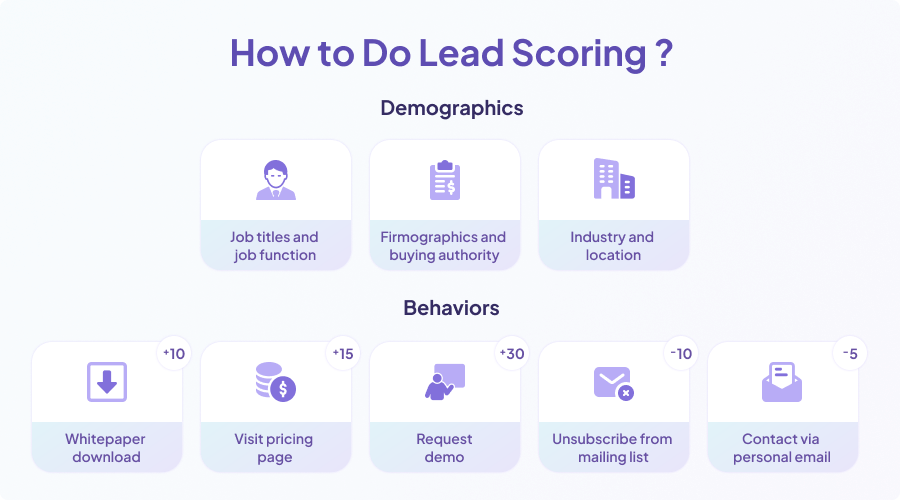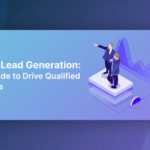Welcome to the marketing wonderland, where leads are the fuel that runs the engine and a robust CRM automation is your faithful companion. You’ve undoubtedly noticed how essential it is to do lead scoring in today’s data-driven marketing landscape.
In the world of B2B marketing, leads are abundant. But quality is scarce.
Lead scoring is one of the most effective ways to establish priority for your leads so that your sales and marketing teams concentrate only on the most important and conversion-ready prospects.
In this blog, we will cover what is lead scoring, how to do lead scoring step by step, the importance of AI lead scoring, and how B2B companies can efficiently scale growth with best lead scoring software.
Quick Summary
- Lead scoring is the process of prioritizing leads by assigning points based on their actions, demographics, and fit.
- Scoring criteria may include page visits, downloads, email engagement, company size, industry, and more.
- Effective lead scoring models combine multiple data points to predict conversion likelihood.
- AI lead scoring uses machine learning to analyze historical data and better identify the most qualified leads.
- Lead scoring automates lead tracking and prioritization, helping sales teams focus on high-intent prospects.
- Lead scoring turns raw data into a clear lead pipeline that your teams can act on with confidence.
What is Lead Scoring?
Lead scoring is the practice of evaluating prospects to determine their relative priority in terms of engagement, fit, and conversion probability. Each lead is allocated a score according on certain actions or characteristics.
- Job title and position
- Company size and revenue
- Industry vertical and stage
- Location (region or country)
- Email opens and click-through rates
- Page views and time on site
- Social media engagement
- Content downloads
- Demo or trial signups
- Purchase history
These activities and demographic information are known as scoring “rules.” Leads that meet the most favorable criteria will have a better ranking.
Why Lead Scoring Matters
Lead scoring helps teams by:
- Saving time and resources: Sales can close only those leads that are “sales-ready” and have demonstrated interest.
- Increasing conversion rates: The most likely to buy customers are moved to the top of the list for outreach.
- Improving marketing ROI: Knowing which campaigns or channels are most likely to yield sales-ready leads.
- Aligning sales and marketing: A common definition of what a “sales-ready” lead is (MQL).
- Driving personalized outreach: The better you understand the behavioral and demographic attributes, the more effective your communications will be.
Types of Lead Scoring Models
Explicit, implicit, and predictive lead scoring are the three most popular types of lead scoring models. Companies use these three systems to aid in the lead generation and scoring process.
1. Explicit Lead Scoring
Explicit lead scoring uses lead data to categorize them by the information provided in their profiles.
- Common explicit data attributes include:
- Job title, level, and role
- Company size and revenue
- Industry or vertical
- Geographic location
These explicit indicators indicate whether the lead falls within the ICP (ideal customer profile).
2. Implicit Lead Scoring
- Website visits and time spent on certain pages
- Downloads, such as whitepapers, eBooks, or case studies
- Email engagement, including opens and click-through rates
- Trial or demo requests
All of these actions signal engagement, so the higher the number of completed activities, the more engaged the lead will be. And that is often a good proxy for interest in your product or service.
3. Predictive / AI Lead Scoring
- Learn behavior and firmographics patterns
- Update lead scores dynamically in real-time
- Continuously evolve based on new information
This makes predictive lead scoring much faster, smarter, and more accurate at predicting conversion likelihood — particularly for organizations with large lead volumes and rich customer datasets.
The best lead scoring software such as Deep Enrich also automates lead scoring and uses automation triggers based on lead activity.
AI Lead Scoring: Next-Gen Qualification Models
AI lead scoring uses predictive algorithms that automatically analyze data — from online behavior to CRM history — to rank leads based on conversion likelihood.
Benefits of AI Lead Scoring
- Eliminate bias in decision-making
- Machine learning is not influenced by emotions, sales rep experience or instincts.
- Lead prioritization is done in real-time.
- Instantly identifies high-intent leads.
- Increase overall pipeline quality
- Machine learning models identify and rank leads by relevance to your ideal customer.
- AI-generated intelligence results in quicker and more precise action, leading to faster conversions and more satisfied customers.
In B2B marketing, where sales cycles are long and deals are large, the AI lead scoring model can make a critical difference.
How to Do Lead Scoring: Step-by-Step Strategy

Step 1: Define your Ideal Customer Profile (ICP)
- Industry type, size, and vertical
- Buyer job title, level, and role
- Typical challenges and goals
- Pain points and decision-making
Step 2: Identify Scoring Factors
Scoring rules are specific lead behaviors or attributes that indicate interest or “readiness” to buy. These rules must be consistent with ICP.
1. Lead scoring factors:
- Downloads (whitepaper, eBook, or case study)
- Email engagement (opens and clicks)
- Landing page visits , Product demos or trials requested
- Customer webinars or events attended
2. Demographic data factors:
- Job titles and job function
- Firmographics and buying authority
- Industry and location
Higher point values should be assigned to activities and demographics that are most relevant to conversion.
Step 3: Assign weights and values
Examples of lead scoring weights:
- Whitepaper download: +10
- Visit pricing page: +15
- Request demo: +30
- Unsubscribe from mailing list: −10
- Contact via personal email: −5
Step 4: Implement in CRM or Lead Scoring Software
Step 5: Review and Refine
- Lead scoring is a dynamic system, and your ideal customer’s definition may change over time.
- The best lead scoring software is not set in stone. Models should be adjusted to match real-life engagement data.
- Regular scoring model revisions will allow you to track the lead conversion rate by score range.
- Lead scoring models also need to evolve with your sales and marketing processes. If a lead behavior previously led to a sale but now does not, it should have its score reduced or removed entirely.
- Periodic reviews allow you to confirm or adjust criteria based on actual performance data.
B2B Lead Scoring: Best Practices
Lead scoring is not a one-size-fits-all process, especially in B2B sales.
Key B2B lead scoring factors:
- Company revenue and size
- Industry vertical, company stage, and location
- Number of decision-makers or influencers
- Lead engagement levels (email, page views)
- Intended time frame for purchase
AI vs. Manual Lead Scoring: Who Wins?
Verdict: Manual lead scoring works fine when the number of leads is low, but if you’re a B2B business with a lengthy and complex buying process, AI lead scoring takes the prize. It’s faster, smarter, and more accurate at qualifying leads.
Lead Scoring Challenges and Solutions
Challenges in scoring and qualifying leads can be overcome with diligence, collaboration, and the right technology.
Insufficient or inaccurate data
- Solution: Dedicate resources for data enrichment. Improve internal data hygiene and use third-party enrichment services where possible.
Sales and marketing misalignment
- Solution: Marketing and sales alignment starts by using the same ICP definition for an ideal customer. Lead scoring system should be simple, intuitive, and consistent with business needs and processes.
Overcomplicated lead scoring models
- Solution: Use rules-based automation systems. Make lead scoring models simple and transparent to share between marketing and sales. Data is the fuel of lead scoring. Ensure data from sales and marketing is well-formed, consistent, and integrated across systems.
Criteria not revised regularly
- Solution: Continually refine scoring factors based on actual sales conversion data. Lead scoring systems are not set in stone. Criteria will also need to evolve over time, or as new data becomes available.
Metrics to Measure Lead Scoring Success
Metrics to monitor in your lead scoring efforts:
- Lead-to-Customer conversion rate
- Number of sales cycles
- Percent of MQLs that become SQLs
- Average deal value
- Customer acquisition cost
- Average marketing qualified lead value
If the conversion rate for your highest-scoring leads is consistently higher than others, your lead scoring model is working.



